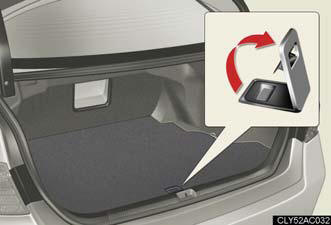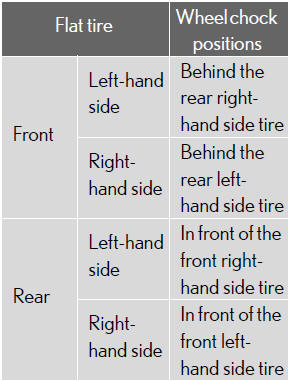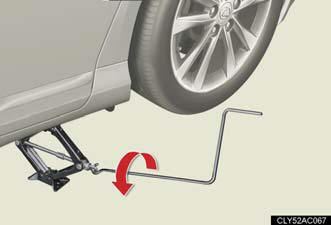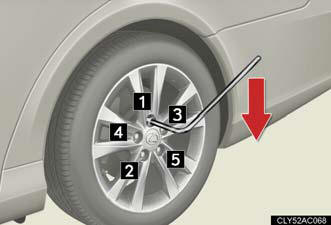If you have a flat tire
Remove the flat tire and replace it with the spare provided.
Before jacking up the vehicle
Stop the vehicle on a hard, flat surface.
- Set the parking brake.
- Shift the shift lever to P.
- Stop the engine.
- Turn on the emergency flashers.
Location of the spare tire, jack and tools

Taking out the jack

Lift up the hook of the panel on the trunk floor.

Secure the panel using the hook provided.

Remove the hook.
Taking out the spare tire

Lift up the hook of the panel on the trunk floor.

Secure the panel using the hook provided.

Loosen the center fastener that secures the spare tire.
Replacing a flat tire

Chock the tires.


Slightly loosen the wheel nuts (one turn).

Turn the jack portion “A” by hand until the notch of the jack is in contact with the jack point.

Raise the vehicle until the tire is slightly raised off the ground.

Remove all the wheel nuts and the tire.
When resting the tire on the ground, place the tire so that the wheel design faces up to avoid scratching the wheel surface.
Installing the spare tire

Remove any dirt or foreign matter from the wheel contact surface.
If foreign matter is on the wheel contact surface, the wheel nuts may loosen while the vehicle is in motion, and the tire may come off the vehicle.

Install the spare tire and loosely tighten each nut by hand to approximately the same amount.
Turn the lug nuts until the washers come into contact with the wheel.

Lower the vehicle.

Firmly tighten each nut two or three times in the order shown in the illustration.
Tightening torque:
10.5 kgf•m (103 N•m, 76 ft•lbf)
Stow the flat tire, tire jack and all tools.
The compact spare tire
The compact spare tire is identified by the label “TEMPORARY USE ONLY” on the tire sidewall.
Use the compact spare tire temporarily only in an emergency.
- Make sure to check the tire pressure of the compact spare tire.
When using the compact spare tire
As the compact spare tire is not equipped with the tire pressure warning
valve and
transmitter, low inflation pressure of the spare tire will not be warned. Also,
if you
replace the compact spare tire after the tire pressure warning light comes on,
the
light remains on.
If you have a flat front tire on a road covered with snow or ice (vehicles
with compact
spare tire)
Install the compact spare tire on the rear of the vehicle. Perform the
following steps
and fit tire chains to the front tires.
1. Replace a rear tire with the compact spare tire.
2. Replace the flat front tire with the tire removed from the rear of the vehicle.
3. Fit tire chains to the front tires.
After completing the tire change
The tire pressure warning system must be reset.
CAUTION:
Using the tire jack
Improper use of the tire jack may lead to death or serious injuries due to the
vehicle
suddenly falling off the jack.
- Do not use the tire jack for any purpose other than replacing tires or
installing and
removing tire chains.
- Only use the tire jack that comes with this vehicle for replacing a flat tire.
Do not use it on other vehicles, and do not use other tire jacks for replacing
tires
on this vehicle.
- Always check that the tire jack is securely set to the jack point.
- Do not put any part of your body under the vehicle supported by a jack.
- Do not start or run the engine while your vehicle is supported by the jack.
- Do not raise the vehicle while someone is in it.
- When raising the vehicle, do not put an object on or under the jack.
- Do not raise the vehicle to a height greater than that required to replace the tire.
- Use a jack stand if it is necessary to get under the vehicle.
Take particular care when lowering the vehicle to ensure that no one working on
or
near the vehicle may be injured.
Replacing a flat tire
Observe the following precautions to reduce the risk of death or serious injury.
- Never use oil or grease on the wheel bolts or wheel nuts.
Oil and grease may cause the wheel nuts to be excessively tightened, leading to
bolt or disc wheel damage. In addition, the oil or grease can cause the wheel
nuts
to loosen and the wheel may fall off, causing a serious accident. Remove any oil
or
grease from the wheel bolts or wheel nuts.
- Have the wheel nuts tightened with a torque wrench to 10.5 kgf•m (103 N•m, 76 ft•lbf) as soon as possible after changing wheels.
Failure to follow these precautions could cause the nuts to loosen and the
wheels
may fall off, which could lead to an accident causing death or serious injury.
CAUTION:
When using the compact spare tire
- Remember that your compact spare tire is specifically designed for use with
your
vehicle. Do not use your compact spare tire on another vehicle.
- Do not use two compact spare tires simultaneously.
- Replace the compact spare tire with a standard tire as soon as possible.
- Avoid sudden acceleration, deceleration and braking, as well as sharp cornering.
Speed limit when using the compact spare tire
Do not drive at speeds in excess of 50 mph (80 km/h) when a compact spare tire
is
installed on the vehicle.
The compact spare tire is not designed for driving at high speeds. Failing to
observe
this precaution may lead to an accident causing death or serious injury.
When the compact spare tire attached
The vehicle speed may not be correctly detected, and the following systems may
not operate correctly:
- ABS & Brake assist.
- VSC.
- TRAC.
- Navigation system (if equipped).
NOTICE:
Do not drive the vehicle with a flat tire.
Do not continue driving with a flat tire.
Driving even a short distance with a flat tire can damage the tire and the wheel beyond repair.
When replacing the tires
When removing or fitting the wheels, tires or the tire pressure warning valve
and
transmitter, contact your Lexus dealer as the tire pressure warning valve and
transmitter
may be damaged if not handled correctly.
To avoid damaging the tire pressure warning valves and transmitters Do not use liquid sealants on flat tires.
Be careful when driving over bumps with the compact spare tire installed on
the
vehicle.
The vehicle becomes lower when driving with the compact spare tire compared to when driving with standard tires. Be careful when driving over uneven road surfaces.
Driving with tire chains and the compact spare tire Do not fit tire chains to the compact spare tire.
Tire chains may damage the vehicle body and adversely affect driving performance.
See also:
Headlight aim
Vertical movement adjusting bolts
- Vehicles with discharge headlights
1. Adjustment bolt A.
2. Adjustment bolt B.
- Vehicles with LED headlights
1. Adjustment bolt A.
2. Adjustment bolt B.
...
Used Lexus IS 250 Models
Introduced for the 2006 model year, the present-generation IS 250 represents
the second iteration of the Lexus IS series. These earlier cars are pretty much
the same as the current model, though t ...
Overview
The Lexus LS 460 flagship luxury sedans debut revised styling, new
electronics and a new optional performance-tuned Sport Package for 2010. Lexus
continues to offer the Lexus LS 460 and long-wheel ...
